Teacher Spotlight

Focus Question:
How will viewing the curriculum as disabled, rather than students, change the way that you develop lessons?
Teacher #1: Middle School Science Teacher
TRANSCRIPT: “Many of us are used to modifying our curriculum, modifying how we teach slightly depending on our learners. But a lot of people out there are still very much just hoping that our learners are going to change, kind of just hoping that if we just change things up slightly, our learners will come more toward where we are with what we are teaching versus thinking of the curriculum is disabled. Because the curriculum is something we can change. Being the teacher in the classroom, technically, even if we let go of control to the students, we are still the ones in control. We are still the adult in the room and the one with the content knowledge at the head of that classroom. So we are the ones that have the capability of changing our curriculum, how it is presented and the students experience with that curriculum. If we forget about changing our learners, and thinking of our learners as disabled, and instead think of the curriculum as disabled, then it’s really going to open a lot of people’s eyes to the fact that we have the strength to change our curriculum and how it is presented to the kids, instead of constantly trying to change the learners. Instead of coming up with one way of presenting material and just hope everybody just jumps on board, we are able to change how material is presented and perhaps do that differentiated small group where you’ve got a group of kids that are really far ahead of the curriculum who can be doing their own extension activities. Like I had a couple of kids in chemistry who really probably know more about chemistry than I do this quarter in 8th grade, oddly enough. All their parents were chemists, I mean these kids were reading AP Chemistry textbooks for fun, they obviously knew everything I was going to be teaching them already in 8th grade. So you know, having them extending something, having the kids that are still trying to figure out what atoms are made of doing something more teach centered…we are really looking at changing up the curriculum and how it is presented versus trying to change our learners and trying to get everyone really into it. “
Teacher #2: High School Social Studies Teacher
TRANSCRIPT: "Viewing the curriculum as disabled and not the student greatly impacts how I develop lessons. I had already thought of the curriculum as being flawed and not appealing to a great number of my students. What I never considered was students not being disabled. The notion gets you thinking. Reading the article makes me think a bit differently about that student. We all have a best practice of how we learn just like so many of the students we label as being disabled."